List of forageable plants facts for kids
Wild plants can be a fascinating source of food if you know what to look for! This article will help you discover some common plants found in nature that humans can eat. Remember, some parts of a plant might be edible, while others are not. Also, some plants need to be cooked before they are safe to eat.
It's super important to always be careful when looking for wild food. Always use a good guide to identify plants very carefully before you even think about eating them. Eating the wrong plant can be very dangerous and make you sick. Some edible plants can also cause allergic reactions in certain people. If you ever feel unwell after trying a wild plant, it's best to get help right away. Also, old or poorly stored plants can cause food poisoning, just like other foods.
This list focuses on wild plants. There are also other lists for edible seeds, mushrooms, flowers, nuts, vegetable oils, and leaves. It's also a great idea to learn about list of poisonous plants so you know what to avoid!
Contents
Discovering Edible Wild Plants
The plants below are listed by their scientific (Latin) names.
Trees and Shrubs You Can Eat
| Plant image | Part image | Common name | Scientific name | Where it grows | Edible parts and how to use them |
|---|---|---|---|---|---|
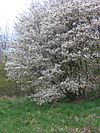 |
 |
Juneberry | Amelanchier lamarckii | Found in Western Europe | Berries (in June) are tasty raw. |
 |
 |
Barberry | Berberis vulgaris | Grows in Europe, North America, northwest Africa, and western Asia | Berries (from July) can be eaten raw, dried as a spice, or cooked into jelly. |
 |
 |
Sweet chestnut | Castanea sativa | Common in woods and parks across Europe and parts of Asia | Nuts (October to November) are delicious raw, roasted, boiled, stewed, or baked. |
 |
 |
Hazel | Corylus avellana | Found in many European woodlands, at the edges of woods, or in old hedges | Hazelnuts (late August to October) can be eaten raw or used in cooking. |
 |
 |
Hawthorn, may-tree | Crataegus monogyna | Native to Europe, northwest Africa, and western Asia; also found elsewhere | Young leaves (in April) are good raw in salads. Berries (in autumn) can be eaten raw or made into jellies, jams, and syrups. |
 |
 |
Beech | Fagus sylvatica | Grows in Europe, south to central Italy, and in mountain forests around the Mediterranean | Nuts (September or October) are good raw, roasted and salted, or pressed for oil. |
 |
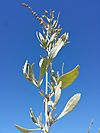 |
Sea purslane | Halimione portulacoides | Found on seashores and salt marshes in western and southern Europe, and from the Mediterranean to western Asia | Leaves can be eaten raw in salads or stir-fried. |
 |
 |
Hop | Humulus lupulus | Native to the temperate Northern Hemisphere: Europe, North America, Asia | Young shoots and leaves (until May) can be cooked like a vegetable. |
 |
 |
Walnut | Juglans regia | Native to Central Asia, but found in temperate zones worldwide | Nuts ripen in September and are great to eat. |
 |
 |
Juniper | Juniperus communis | Grows across the Northern Hemisphere in North America, Europe, and Asia | Berries (both green and dark) are bitter raw, but used as a spice, for drinks, as jam, or roasted for a coffee substitute. |
 |
 |
Oregon-grape | Mahonia aquifolium | Native to North America, sometimes found in Europe | Berries can be eaten raw (though they are a bit sour) or made into jelly. |
 |
 |
Crabapples | Malus sylvestris and other Malus species | Malus is native to the temperate zone of the Northern Hemisphere, in Europe, Asia, and North America | Fruit (from July) can be eaten raw. If they are too bitter, cook them into jelly (they have lots of pectin!). |
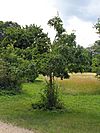 |
 |
Medlar | Mespilus germanica | Found from Southeast Europe to West Asia, sometimes in Britain | Fruit (in November) is edible after it has softened for a few weeks, a process called bletting. |
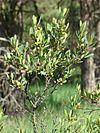 |
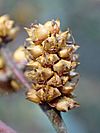 |
Bog-myrtle, sweet willow, Dutch myrtle, sweetgale | Myrica gale | Grows in parts of the northern hemisphere, including Japan, North Korea, Russia, Europe, and North America | Leaves can be dried for tea or used raw to stuff roast chicken. Nutlets and dried leaves are used as seasoning, even for beer. |
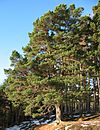 |
 |
Scots pine | Pinus sylvestris | Native to Europe and Asia | Young needles (April to August) can be boiled for tea or soaked in olive oil for a fragrant oil. Nuts are tiny and hard to get from cones, but are edible raw. |
 |
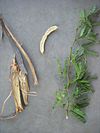 |
Mesquite | Prosopis juliflora | Native to Southern America, but found worldwide in dry, hot places as an invasive plant | Seed pods can be eaten raw or boiled, dried and ground into flour, or fermented to make a mild alcoholic drink. |
 |
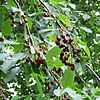 |
Wild cherry | Prunus avium | Native to Europe, western Turkey, northwestern Africa, and western Asia; found in hedgerows and woods | Cherries are delicious raw. |
 |
 |
Bullace, damson, other wild plums | Prunus domestica subsp. insititia | Prunus species are found across the northern temperate regions of the globe | Fruit (ripe from early October) can be eaten raw. |
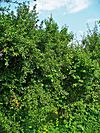 |
 |
Sloe, blackthorn | Prunus spinosa | Native to Europe, western Asia, and parts of northwest Africa; also found in New Zealand and eastern North America | Berries are very sour raw unless picked after the first few days of autumn frost. |
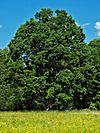 |
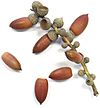 |
English / French oak | Quercus robur | Native to most of Europe, and from Anatolia to the Caucasus, and parts of North Africa | Acorns (ripening in September to October) are too bitter raw. They can be chopped and roasted as an almond substitute, or ground for a coffee substitute. After soaking in water to remove bitterness, acorn meal can be used like flour. |
 |
 |
Golden currant | Ribes aureum | Native to northwest North America | Berries are edible raw but tart. |
 |
 |
Wax currant | Ribes cereum | Native to western North America | Berries are edible raw but might be slightly toxic, so be careful. |
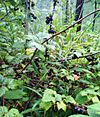 |
 |
Blackcurrant | Ribes nigrum | Native to north-central Eurasia | Berries are often used in jams. |
 |
 |
Redcurrant | Ribes rubrum | Native to western Europe | Berries are used in jams and kissel. |
 |
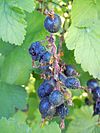 |
Flowering currant | Ribes sanguineum | Western United States and Canada | Berries are edible raw and used in jams. |
 |
 |
Elder | Sambucus nigra | Grows in Europe, North Africa, Central Asia, and Anatolia | Flowers (June to July) can be eaten raw in salads, pickled, or used to make tea or drinks. Berries (August to October) are edible when ripe (turning upside down) and cooked; raw berries are mildly poisonous. |
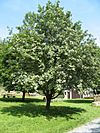 |
 |
Whitebeam | Sorbus aria | Found in Central and southern Europe | Berries are edible raw once they are very ripe and soft (bletted). |
 |
 |
Rowan, Mountain-ash | Sorbus aucuparia | Native to most of Europe (except the far south) and northern Asia | Berries (August to November) are bitter, but can be cooked into jelly or used for flavoring. |
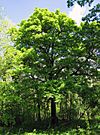 |
 |
Wild service-tree | Sorbus torminalis | Native to Europe, south to northwest Africa, and southeast to southwest Asia | Berries (from September) are edible raw, but hard and bitter unless they are softened (bletted). |
 |
 |
Lime | Tilia × europaea | Sometimes found wild in Europe, or commonly grown in parks and along roads | Flowers (in full bloom, June or early July) can be used to make a tea (popular in France as tilleul). Leaves (without stalks) are good raw in salads. |
Edible Herbaceous Plants
| Plant image | Part image | Common name | Scientific name | Where it grows | Edible parts and how to use them |
|---|---|---|---|---|---|
 |
Yarrow | Achillea millefolium | Native to temperate regions of the Northern Hemisphere | All parts in small amounts, especially young leaves. | |
 |
 |
Amaranth, pigweed, tumbleweed | Amaranthus retroflexus | Native to tropical Americas, but found worldwide | Leaves can be boiled like a vegetable, or eaten raw if young. Seeds can be eaten raw or toasted, or ground into flour. |
 |
 |
Spear saltbush, common orache | Atriplex patula | Found in semi-arid deserts and coastal areas in Asia, North America, Europe, and Africa | Young leaves and shoots can be eaten raw or cooked like spinach. |
 |
 |
Ice plant, sour fig | Carpobrotus edulis | South Africa and many places with similar climates, like Australia, California, and the Mediterranean | Figs (May to July) are edible raw. |
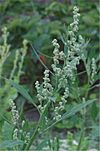 |
 |
Fat-hen, wild spinach | Chenopodium album | Found worldwide in nitrogen-rich soils, especially on wasteland | Leaves and young shoots can be eaten raw or cooked like a green vegetable. |
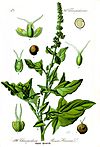 |
Good-King-Henry | Chenopodium bonus-henricus | Most of Europe, West Asia, and eastern North America | Young shoots (until early summer) can be cooked like asparagus. Leaves (until August) can be cooked like spinach. | |
 |
 |
Cogongrass | Imperata cylindrica | Native to tropical and subtropical Asia, but found worldwide as an invasive species | Young flowers and shoots can be cooked. Roots can be chewed raw. Ash can be used as a salt substitute. |
 |
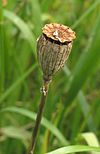 |
Poppy | Papaver rhoeas | Found worldwide, mainly in northern temperate zones | Seeds (from September, when dry and gray-brown) are edible raw as a spice or flavoring. |
 |
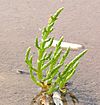 |
Samphire, glasswort, pickleweed, sea beans, sea asparagus | Salicornia species | Grows on seashores and other salty places in the northern hemisphere and southern Africa | Young shoots (June or July) can be eaten raw or cooked, and also pickled. |
 |
 |
Bladder campion, maidenstears | Silene vulgaris | Found as a wildflower in temperate zones of Europe, Western Asia, North Africa, and North America | Young shoots and leaves can be eaten raw. Older leaves can also be cooked. It's a special food in parts of the Mediterranean. |
 |
 |
Chickweed | Stellaria media | Found worldwide, growing annually in colder climates and as a perennial evergreen elsewhere | Stems and leaves can be eaten raw or cooked. |
 |
 |
Dandelion | Taraxacum officinale | Native to Eurasia, but found elsewhere | Leaves are edible raw or cooked when older. |
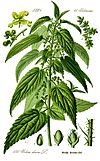 |
 |
Stinging nettle | Urtica dioica | Very common in Europe and Asia, less common in North America | Young shoots and leaves (until May) are edible after soaking or boiling them like a vegetable, or used in soups or purees. |
See also

